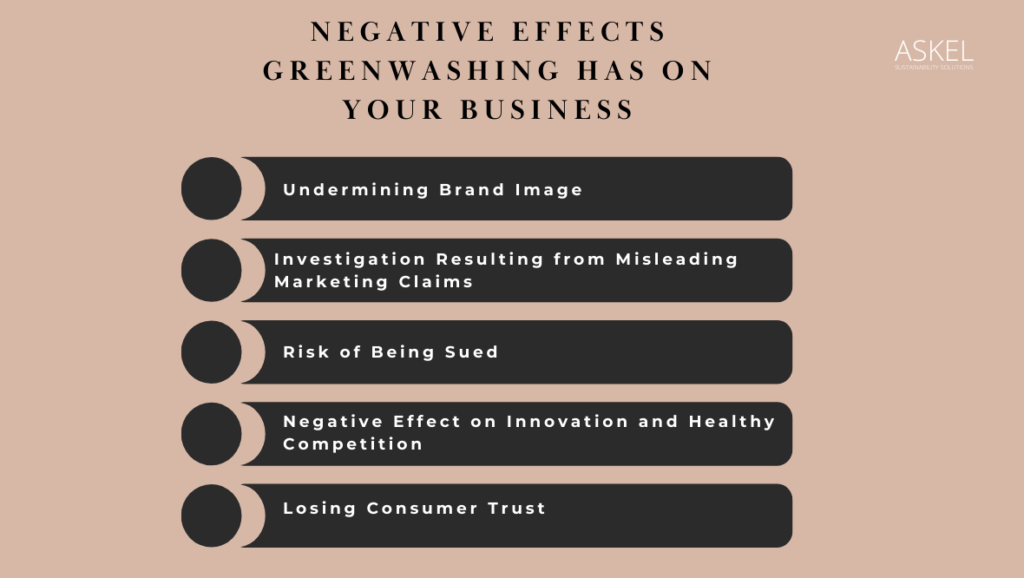7 Ways Businesses Can Avoid Inadvertent Greenwashing

Learn how businesses can prevent unintentional greenwashing by understanding the pitfalls while ensuring transparency and credibility.
Greenwashing is the practice of making misleading or unsubstantiated claims about the environmental impacts that the operations of a business have. While greenwashing is at times intentional, it can also often be unintentional. Businesses may inadvertently greenwash in lieu of a lack of information about their own impacts, or due to a lack of understanding of what constitutes greenwashing.
Even though it is unintentional the risks and consequences of greenwashing for businesses remain the same. It can damage consumer trust, erode brand reputation, and lead to legal liability. Additionally, unintentional greenwashing can undermine the efforts of businesses that are truly committed to sustainability.
In this article, we will discuss seven ways that businesses can avoid inadvertent greenwashing. These tips will help businesses market their products and services, as well as share their impacts with stakeholders in a way that is both ethical and accurate.
1. Understanding Greenwashing
To best understand greenwashing it is useful to look at what it might look like in the real world.. Here are a few examples of the different forms of greenwashing:
- Using vague or unsubstantiated environmental claims, such as “natural” or “eco-friendly”
- Making claims about the environmental impact of a product or service that cannot be backed by relevant data and studies.
- Using vague images or symbols that create the impression that a product or service is environmentally friendly
When understanding greenwashing it is important for businesses to factor in its negative consequences, not only for themselves, but also for their stakeholders. The list of these negative impacts is long but here are a few fundamental ones:
- Undermining brand image
- Regulatory risks
- Financial losses (marketing and advertising costs, legal costs, penalties and damages etc.)
- Losing B2B partners
- Affecting consumer health and safety
- Violation of consumer trust
- Hindering and delaying real change
Click to learn in detail about the Negative Effects of Greenwashing on Businesses
Click to learn in detail about the Negative Effects of Greenwashing on Consumers

2. Education and Training
One of the best ways for businesses to avoid greenwashing is to educate and train their management and employees, especially marketing and communications departments, about communicating about environmental impacts. This will help them understand the risks of greenwashing and to make more informed decisions about the claims that they make.
There are a number of ways that businesses can educate and train their employees about greenwashing. One option is to provide training on environmental issues and sustainability marketing. This training should cover topics such as:
- What greenwashing is and why it is harmful
- How to identify greenwashing
- How to make ethical and accurate sustainability claims
- How to avoid common greenwashing pitfalls
Another option is to develop internal guidelines and policies on sustainability marketing. These guidelines and policies should provide clear guidance on what claims employees are allowed to make about the environmental benefits of the company’s products and services.
By educating and training their employees about greenwashing, businesses can help to ensure that their marketing and communication materials are ethical and accurate. This will in turn help to build trust with consumers and protect the company’s reputation.

3. Be Mindful of Proportionality
Proportionality is an important concept to consider when making environmental claims. Businesses should make sure that the weight of their environmental claims is proportional to the extent of the environmental impact of their products or services.
For example, if a company is making claims about its commitment to reducing waste, while it is part of a low-waste industry, while not communicating or focusing on its emissions which are sizeable by industry standards, it can be construed as misleading.
Additionally, if you are making any environmental claims, make sure that they are supported by strong evidence, such as credible data-backed studies.
Here are some additional tips for businesses on how to be mindful of proportionality in their sustainability marketing:
- Avoid making environmental claims about minor aspects of your products or services.
- Focus your environmental claims on the most significant aspects of your environmental impact.
- Be clear and concise in your environmental claims.

4. Get Feedback – Stakeholder Engagement
One of the best ways to avoid greenwashing is to get feedback from stakeholders, including consumers, environmental organizations, and other businesses. This feedback can help businesses identify any potential greenwashing risks and make sure they are up to speed on how their communication regarding environmental impacts and initiatives is being interpreted by their stakeholders.
When getting feedback from stakeholders, businesses should ask specific questions, such as:
- Is there a risk that this statement could look like greenwashing to the general public?
- Are there any precedents of similar statements being construed as greenwashing?
Businesses should also be open to receiving critical feedback. If a stakeholder or stakeholder group raises concerns about a particular environmental claim, the business should take those concerns seriously and take necessary action.
By getting feedback from stakeholders, businesses can reduce risk and build trust with consumers. This can lead to a number of benefits, including increased sales, improved brand reputation, and reduced legal liability.
Here are some additional tips for businesses on how to get feedback from stakeholders to avoid greenwashing:
- Establish a process for collecting and reviewing feedback from stakeholders.
- Make it easy for stakeholders to provide feedback. This could be done through a website form, email address, or social media.
- Respond to feedback promptly and professionally.
- Be transparent about how you are using feedback to improve your sustainability marketing materials.

5. Be Aware of Regulations and Real-world Implementation
In addition to the risks to consumer trust and brand reputation, businesses that greenwash may also face legal action. Many countries have laws and regulations in place to protect consumers from misleading environmental claims. For example, in the United States, the Federal Trade Commission (FTC) provides guidelines on environmental marketing has the authority to take action against businesses that make false or misleading environmental claims.
When evaluating your environmental impact-related marketing materials, it is important to be aware of the relevant laws and regulations in your jurisdiction. One way to reduce the risk of legal action is to get your environmental claims audited and certified by a third-party organization. This shows that your claims have been independently verified and that they meet certain standards.
6. Back up your Claims with Evidence
One of the best ways to avoid greenwashing is to back up your environmental claims with evidence and communicate them through standardized mediums such as sustainability reports. This shows that you are committed to transparency and that you are serious about sustainability.
There are a number of different types of evidence that you can use to back up your environmental claims, including:
- Third-party certifications: Third-party certifications, such as Energy Star and LEED, verify that your products or services meet certain environmental standards.
- Independent research studies: Independent research studies such as Emissions Accounting or LCA (Life-cycle Assessment) can provide evidence of the environmental impact of your products or services.
- Internal data: Your own internal data can be used to back up your environmental claims, such as data on your energy consumption, water usage, and waste production.
When choosing evidence to back up your environmental claims, it is important to select evidence that is relevant, reliable, and accessible to consumers. For example, if you are making a claim about the carbon footprint of your product, you should provide additional information regarding how the data was collected, tools and calculation methodology used, etc.

7. Certifications: Quality over Quantity
Third-party certifications are a valuable way to demonstrate your commitment to sustainability and to back up your environmental claims. However, it is important to choose certifications that are credible and that meet high standards.
When choosing a certification, you should consider the following factors:
- The reputation of the certifying organization: The certifying organization should be accredited and have a good reputation for rigor and independence.
- The scope of the certification: The certification should cover the specific environmental claims that you are making.
- The requirements for certification: The requirements for certification should be comprehensive and challenging.
It is also important to note that not all certifications are created equal. Some certifications are more rigorous and credible than others. When choosing a certification, it is important to do your research and select a certification that is well-respected in your industry.
It is better to have one credible certification than several less credible certifications. Having too many certifications can confuse consumers and make it difficult for them to assess your environmental impact.


